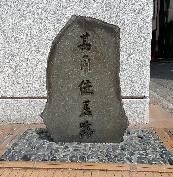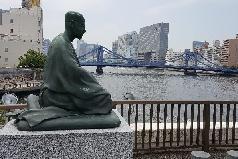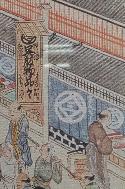 Under the theme of "Haiku," we will introduce Kikaku Enomoto (later Kikaku Takarai), a poet who gained popularity during the Edo period, and spots related to the corner. We hope that you will feel familiar with the phrases written by the corner, the time and city where the corner spent.
Under the theme of "Haiku," we will introduce Kikaku Enomoto (later Kikaku Takarai), a poet who gained popularity during the Edo period, and spots related to the corner. We hope that you will feel familiar with the phrases written by the corner, the time and city where the corner spent.
 Also, I heard the news that a promotion council was established to make Haiku UNESCO Intangible Cultural Property. If approved, Haiku will get more attention.
Also, I heard the news that a promotion council was established to make Haiku UNESCO Intangible Cultural Property. If approved, Haiku will get more attention.
1. The haiku poet, Kikaku
 There is a monument to the site of the corner residence in Kayabacho, Nihonbashi, Chuo-ku.
There is a monument to the site of the corner residence in Kayabacho, Nihonbashi, Chuo-ku.

 Monument, the ruins of the corner residence (Kayabacho, Chuo-ku)
Monument, the ruins of the corner residence (Kayabacho, Chuo-ku)
 Matsuo Basho, a poet from the Edo period, established haikai in the literary arts. "Sokaku" is the disciple of Basho, which is counted as Shomonjittsu.
Matsuo Basho, a poet from the Edo period, established haikai in the literary arts. "Sokaku" is the disciple of Basho, which is counted as Shomonjittsu.
 In contrast to Basho who wrote tranquility, the corner wrote many stylish phrases based on Edo. After Basho's death, the corner caused "Edoza" and gained even more popularity with a stylish phrase reflecting the Edo kid's temperament.
In contrast to Basho who wrote tranquility, the corner wrote many stylish phrases based on Edo. After Basho's death, the corner caused "Edoza" and gained even more popularity with a stylish phrase reflecting the Edo kid's temperament.

 Basho Okina Statue and Historic Site Observation Garden (Tokiban, Koto-ku)
Basho Okina Statue and Historic Site Observation Garden (Tokiban, Koto-ku)
 Now, let's take a look at the verse. In the following, both are phrases that describe Edo. (Please read the next page (continued) for the meaning of phrases and places related to them.)
Now, let's take a look at the verse. In the following, both are phrases that describe Edo. (Please read the next page (continued) for the meaning of phrases and places related to them.)
 The sound and changing clothes in Echigo-ya
The sound and changing clothes in Echigo-ya
 There is no day when a bell can't be sold. Spring in Edo
There is no day when a bell can't be sold. Spring in Edo

 Hirodai Shoran (Echigoya kimono store)
Hirodai Shoran (Echigoya kimono store)
More The sound and changing clothes in Echigo-ya
![]() The Nihonbashi Library in Chuo Ward completed all renovation work last month, so I went there immediately.
The Nihonbashi Library in Chuo Ward completed all renovation work last month, so I went there immediately.![]()
![]() Nihonbashi Library also had local materials and old maps.
Nihonbashi Library also had local materials and old maps.![]()
![]() If you live or work nearby, why don't you use it?
If you live or work nearby, why don't you use it?![]()

